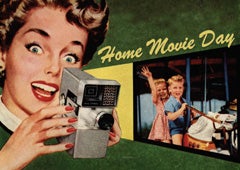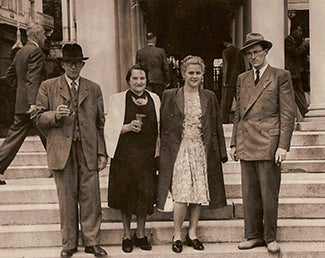This year, due to scheduling issues, Los Angeles celebrated “Home Movie Day” at the Academy of Motion Picture Arts & Sciences' Linwood Dunn Theater in the Pickford Center on October 12, 2013, while in much of the rest of the nation the event occurs a week later, on October 19. Then again, if you go to the Home Movie Day website, there are lots of places doing Home Movie Day on other days in October, even November, like Buenos Aires, Argentina.
So first of all, I want to make a shameless plug for UCLA Film & Television Archive staff member Trisha Lendo’s blog on home movies, and home movies at UCLA. Like many Archives, UCLA now takes home movies seriously, but that it is a relatively new development in our field.
Secondly, I’m truly amazed and gratified that the idea of Home Movie Day, as a way to showcase the cinematic work of the everyman, has caught on, not only all over this country, but now all over the world, including in Austria, Finland, Spain, Switzerland, Japan, Poland, Brazil, among others. Started just eleven years ago, in 2002, Home Movie Day was the brain child of a group of young generation moving image archivists concerned about the preservation status of home movies. I’m honored by the fact that I know most of the founders personally, including one of my former students, Snowden Becker, who is now Program Manager for the UCLA Moving Image Archive Studies program.
I can also claim some responsibility for putting home movies on the agenda for film archivists. Back in 1998, I published a piece in FIAF’s The Journal of Film Preservation, “Out of the Attic: Archiving Amateur Films,” which reported on the International Federation of Film Archives’ conference in 1997 in Columbia on amateur films. As I noted at the time, anything but 35mm was a revolutionary concept for FIAF, which as an international institution was still almost solely focused on fiction features, theatrical documentaries and newsreels. The first panel of the amateur film symposium featured the perplexed looks of archivists from some of FIAF’s founding national film archives when facing the topic of home movies, which resembled those of the virgin discovering her baby. Happily, the Symposium eventually concluded that the history of cinema in many Latin American countries was almost exclusively a history of home movies.
Then in the year 2000, I worked together with Karan Sheldon to develop and write a National Endowment for the Arts grant to fund a major symposium at the 2001 Association of Moving Image Archivists conference in Portland on small gauge film archiving. That grant proposal did get funding, and the symposium was a major success, including small gauge task force sessions on 9.5mm, a small gauge technical orientation, screenings from California amateur clubs and home movies as folk art, and a session on the research value of home movies.
 But what I really wanted to write about was my dad, Jerry (Jaromir) Horak, who was an amateur filmmaker, although I didn’t know that for a very long time. I had to get interested in cinema studies as an undergraduate, go to graduate school in filmmaking, complete an internship at a major American film archive, get my PhD. in film, and become a film curator, before my dad fessed up. One day in the mid 1990s, while I visited him in Prague, he showed me a VHS video of all several hours of home movies he had had transferred from film. Sure, I knew he had shot a few Kodachrome 8mm films of me and my two brothers at the lake in Wisconsin on our summer vacations in the late 1950s, but I had no idea he had first picked up an 8mm Kodak in 1936 in Prague, when he was fifteen. Before the war, he shot mostly films of family vacations, skiing in the Tatra Mountains, or swimming at the beach in Split (then Yugoslavia), and images of family, relatives, and friends playing tennis or bowling at the family’s country house in the foothills of western Bohemia in Řeničov. There are humorous moments with the family dog, a manic wire haired terrier named Timmy, and scenes with my grandparents and my Aunt Libuse, my dad’s sister who is still with us. My grandfather was director of one of the Czech Republic’s largest producer of electrical turbines, so dad’s films document the lap of haute bourgeois luxury, Central European style.
But what I really wanted to write about was my dad, Jerry (Jaromir) Horak, who was an amateur filmmaker, although I didn’t know that for a very long time. I had to get interested in cinema studies as an undergraduate, go to graduate school in filmmaking, complete an internship at a major American film archive, get my PhD. in film, and become a film curator, before my dad fessed up. One day in the mid 1990s, while I visited him in Prague, he showed me a VHS video of all several hours of home movies he had had transferred from film. Sure, I knew he had shot a few Kodachrome 8mm films of me and my two brothers at the lake in Wisconsin on our summer vacations in the late 1950s, but I had no idea he had first picked up an 8mm Kodak in 1936 in Prague, when he was fifteen. Before the war, he shot mostly films of family vacations, skiing in the Tatra Mountains, or swimming at the beach in Split (then Yugoslavia), and images of family, relatives, and friends playing tennis or bowling at the family’s country house in the foothills of western Bohemia in Řeničov. There are humorous moments with the family dog, a manic wire haired terrier named Timmy, and scenes with my grandparents and my Aunt Libuse, my dad’s sister who is still with us. My grandfather was director of one of the Czech Republic’s largest producer of electrical turbines, so dad’s films document the lap of haute bourgeois luxury, Central European style.
On November 17, 1939, eight months after Hitler’s Wehrmacht overran Czechoslovakia, the Nazis threw my father, a 19 year old student at the Technical University in Prague, into a German concentration camp, although he was completely innocent of any political activity.
 My dad picked up his camera again to document the funeral of Jan Masaryk, the Czech Foreign Minister who was defenestrated by the Czech Communist secret police in the Putsch of 1948. According to my dad, the communist dominated police confiscated his camera and film, because images not produced by the government were automatically perceived as a threat; it was the last film he ever shot before he went into exile. After my dad passed away in 2005, I found at least one long 8mm reel with footage of the Masaryk funeral and its long parade of official and unofficial mourners, marching as if carrying the democratic republic of Czchoslovakia to its grave (which they were). One of these days, I’ll show my dad’s work at Home Movie Day.
My dad picked up his camera again to document the funeral of Jan Masaryk, the Czech Foreign Minister who was defenestrated by the Czech Communist secret police in the Putsch of 1948. According to my dad, the communist dominated police confiscated his camera and film, because images not produced by the government were automatically perceived as a threat; it was the last film he ever shot before he went into exile. After my dad passed away in 2005, I found at least one long 8mm reel with footage of the Masaryk funeral and its long parade of official and unofficial mourners, marching as if carrying the democratic republic of Czchoslovakia to its grave (which they were). One of these days, I’ll show my dad’s work at Home Movie Day.






 Mobile Navigation
Mobile Navigation

